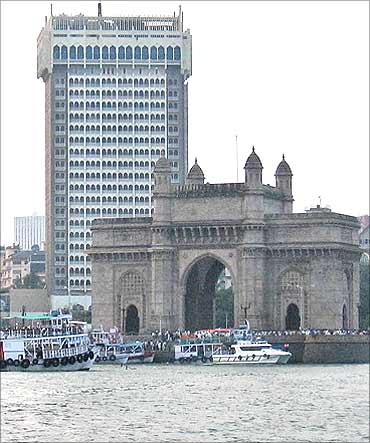Image: FDI inflows fall.
Prakash Chawla & Nishikant Dwivedi in New Delhi
 India received less foreign direct investment in 2010 than the previous year, courtesy a modest recovery in the global economy which reduced the risk and expansion appetite of corporates across the world. Foreign Direct Investment (FDI) inflows into the country between January-October this year aggregated $17.37 billion, compared to $23.8 billion in the corresponding year-ago period, translating into a 27 per cent decline. Neither the government, nor the state of economy can be faulted for the big decline in fresh foreign equity investment in India. A recent World Bank report -- 'World Investment and Political Risks' -- gives an apt reason for the dip in FDI into developing countries.
India received less foreign direct investment in 2010 than the previous year, courtesy a modest recovery in the global economy which reduced the risk and expansion appetite of corporates across the world. Foreign Direct Investment (FDI) inflows into the country between January-October this year aggregated $17.37 billion, compared to $23.8 billion in the corresponding year-ago period, translating into a 27 per cent decline. Neither the government, nor the state of economy can be faulted for the big decline in fresh foreign equity investment in India. A recent World Bank report -- 'World Investment and Political Risks' -- gives an apt reason for the dip in FDI into developing countries.
Prakash Chawla & Nishikant Dwivedi in New Delhi
 India received less foreign direct investment in 2010 than the previous year, courtesy a modest recovery in the global economy which reduced the risk and expansion appetite of corporates across the world. Foreign Direct Investment (FDI) inflows into the country between January-October this year aggregated $17.37 billion, compared to $23.8 billion in the corresponding year-ago period, translating into a 27 per cent decline. Neither the government, nor the state of economy can be faulted for the big decline in fresh foreign equity investment in India. A recent World Bank report -- 'World Investment and Political Risks' -- gives an apt reason for the dip in FDI into developing countries.
India received less foreign direct investment in 2010 than the previous year, courtesy a modest recovery in the global economy which reduced the risk and expansion appetite of corporates across the world. Foreign Direct Investment (FDI) inflows into the country between January-October this year aggregated $17.37 billion, compared to $23.8 billion in the corresponding year-ago period, translating into a 27 per cent decline. Neither the government, nor the state of economy can be faulted for the big decline in fresh foreign equity investment in India. A recent World Bank report -- 'World Investment and Political Risks' -- gives an apt reason for the dip in FDI into developing countries. ...
India's FDI inflows dip in 2010
Image: India's GDP rises. India was no exception, though it showed rather impressive economic growth, kissing 9 per cent. "Multinational enterprises were hit hard by the global economic recession and financial crisis of 2008. Slower global growth in 2008 and 2009 squeezed their profitability, while global economic uncertainty, weak global demand and the credit crunch affected their willingness and ability to expand overseas," the report pointed out. Yes, there was a recovery, but then, as the World Bank researchers show, the "rebound was anaemic in light of the severity of the recession, especially in the developed world".
India was no exception, though it showed rather impressive economic growth, kissing 9 per cent. "Multinational enterprises were hit hard by the global economic recession and financial crisis of 2008. Slower global growth in 2008 and 2009 squeezed their profitability, while global economic uncertainty, weak global demand and the credit crunch affected their willingness and ability to expand overseas," the report pointed out. Yes, there was a recovery, but then, as the World Bank researchers show, the "rebound was anaemic in light of the severity of the recession, especially in the developed world".
India's FDI inflows dip in 2010
Image: Wal-Mart store.
At the policy level, the demand for opening up the multi-brand retail sector to global chains like Wal-Mart and Carrefour gained momentum following a government discussion paper inviting a public debate on the politically sensitive issue. In fact, the issue was invariably on the wish list of every head of state visiting India, including US President Barack Obama and French President Nicolas Sarkozy. But then, given the political environment and the UPA coming under fire over scams and controversies, it appears to be a distant priority of the government to go for the kill and throw open the sector, which is seen as a bread-and-butter issue for millions of kirana shops.
India's FDI inflows dip in 2010
Image: FDI is no more a one-way street for India.
The proposal is being vetted by various ministries, as Commerce and Industry Minister Anand Sharma would like to follow a "calibrated approach". At present, FDI up to 51 per cent is allowed in the single-brand retail format, while 100 per cent is permitted in the wholesale cash-and carry business. With domestic corporates going global, FDI is no more a one-way street for India, with outward investment also assuming a critical size. As per the RBI's latest figures, direct investment abroad increased by $ 2.8 billion in the April-June period of the current fiscal.
India's FDI inflows dip in 2010
Image: FDI flows originating from developing nations rebounded. The economic crisis had dampened developing countries' outward investment in 2009, when FDI declined by 28 per cent to $149 billion,according to the World Bank report. However, FDI flows originating from developing nations rebounded smartly to an estimated $185 billion in 2010. The Department of Industrial Policy and Promotion, the nodal agency on FDI policy in India, also showed its intent to hike the FDI cap in the defence sector by putting a discussion paper in the public domain. But then, there is no meeting of minds within the government, as the main opposition has come in from the Defence Ministry and establishment. As in the past, Mauritius remained the top source of FDI, thanks to its much-talked about double taxation avoidance treaty with India. Broadly, companies from Singapore, the US, UK, Germany, Japan, France and UAE were the major investors during the year.
The economic crisis had dampened developing countries' outward investment in 2009, when FDI declined by 28 per cent to $149 billion,according to the World Bank report. However, FDI flows originating from developing nations rebounded smartly to an estimated $185 billion in 2010. The Department of Industrial Policy and Promotion, the nodal agency on FDI policy in India, also showed its intent to hike the FDI cap in the defence sector by putting a discussion paper in the public domain. But then, there is no meeting of minds within the government, as the main opposition has come in from the Defence Ministry and establishment. As in the past, Mauritius remained the top source of FDI, thanks to its much-talked about double taxation avoidance treaty with India. Broadly, companies from Singapore, the US, UK, Germany, Japan, France and UAE were the major investors during the year.
India's FDI inflows dip in 2010
Image: India's services sector benefits from FDI. India's services sector, both financial and non-financial, also continued to be a favourite investment avenue for foreign companies, attracting about $10 billion of FDI in the first seven months of 2010-11.
India's services sector, both financial and non-financial, also continued to be a favourite investment avenue for foreign companies, attracting about $10 billion of FDI in the first seven months of 2010-11. It was followed by the computer software and hardware, telecommunications and housing and real estate sectors. Maharashtra, Delhi and parts of Uttar Pradesh and Haryana adjoining the national capital topped the list of states attracting FDI.
For the benefit of foreign investors, the government also consolidated all existing regulations on FDI contained in FEMA, RBI circulars and various press notes into a single document.
The aim was simplification of the policy, greater clarity and understanding of foreign investment rules among overseas investors and sectoral regulators.







article